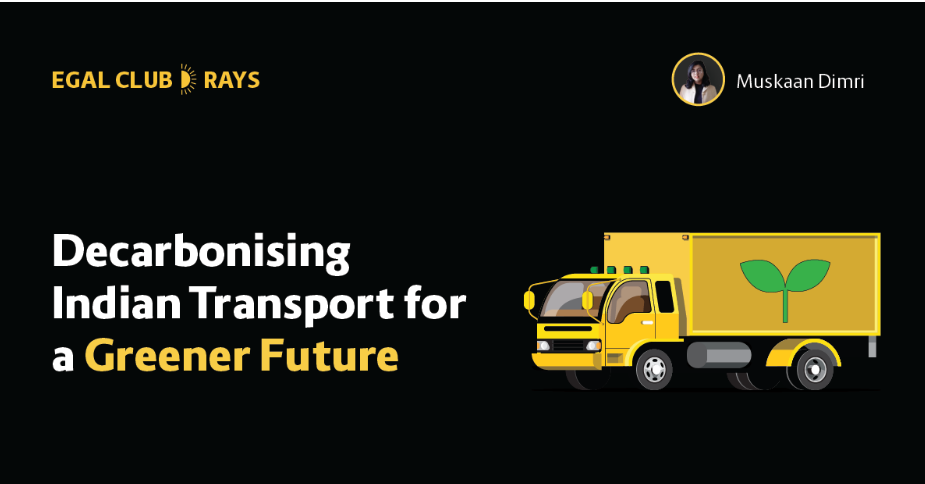India being the 2nd most populous nation and 7th largest economy is diversified and one of the global players in agriculture, industry, services and manufacturing. As an emerging market, India is one of the world’s largest automobile and two-wheeler manufacturers. It also has the fourth largest rail network and the fastest growing aviation market. The dependence of aviation, shipping and trucking on oil- and natural gas-based fuels has made these sectors the world’s largest emitters of greenhouse gasses (including carbon dioxide and methane).
EMISSIONS FROM HEAVY TRANSPORT
It is reported that the transport sector accounts for 13.5% of the country’s energy-related CO2 emissions, and road transport accounts for 90% of the sector’s final energy consumption. Road transport includes passenger transport and freight carried by trucks (commercial freight). According to the Energy, Environment and Water Council, freight movements in India increased by 125% between 2005 and 2020. This increase is mainly dominated by truck traffic and not by rail or inland waterways. India’s truck market is expected to quadruple by 2050, according to a September 2022 report by Niti Aayog and RMI, an international non-profit organization working to transform the energy system. NITI Aayog is at the forefront of promoting electric vehicles and sustainable mobility through its “National Mission for Transformative Mobility and Battery Storage”.
COP26 – THE WAY FORWARD
India has joined the First Movers Coalition, a global initiative to decarbonise heavy industry and long-haul transport. Launched by US President Joe Biden and his WEF at COP26 as a flagship public-private partnership to clean up the most carbon-intensive sectors, the addition of 50 new corporate members brings the total market capitalization of 8.5 trillion USD.
In addition to India, Denmark, Italy, Japan, Norway, Singapore, Sweden and the UK have also joined the US as government partners to create nascent cleantech markets through policy action and private sector engagement. An evaluation framework for transport emissions will be created specifically for India as part of the Decarbonizing Transport in India initiative. The government will have a thorough grasp of past, present, and projected transportation activities, as well as the associated CO2 emissions, to use as a decision-making tool.
The ITF project team will collaborate closely with Indian government agencies, regional decision-makers, academics, industry professionals, and civil society organizations. The creation of policies will be aided by stakeholder workshops, training sessions, briefings for policymakers, and mitigation action plans after the project has ended.
GREEN SHIPPING- AN ALTERNATIVE
Despite the fact that shipping is regarded as being more environmentally friendly than flying or driving, the high sulphur content of the fuel is a significant issue. For the transportation of one tonne over one kilometer, the specific energy consumption (SEC) can be used as a benchmark, with ships having a value of five to ten and freighters having a value of between 400 and 600 g/t km. An insignificant amount of emissions are caused by shipping. However, in order to lower the carbon dioxide emissions from the maritime sector, the Ministry of Ports, Shipping, and Waterways established a programme for green ports and green shipping in January 2022. The project seeks to advance a green ecosystem by, for instance, utilizing renewable energy for port operations. However, port expansion efforts have also violated environmental laws and seriously harmed the coastal ecosystem, leading to decreased fish catches and soil erosion.
MODAL SHIFTING- A NEW WAY OF THINKING
Government’s model of electrification and the decarbonization of the power sector are necessary to cut emissions, but demand-side policies might help ease the burden on the amount of electrified transportation required. By avoiding the reliance on novel technologies that are frequently expensive and not yet available at commercial scale, a modal shift away from personal transportation modes enables emissions reductions. Demand for electrified 2W, 3W, and LDVs is 88% lower under the rail-focused scenario than it is under the road-focused scenario, while demand for electrified HDVs is 80% lower. In order to ease the burden on the usage of private passenger vehicles, safe, efficient, dependable, and multimodal (public) transport services are essential. The number of automobiles in metropolitan areas can be reduced via congestion and low emission zones.
Electric railroads that are secure and dependable can especially ease the strain on the road system. India’s rail network has essentially remained the same for the last 60 years with comparatively little investment, in contrast to the country’s road network, which increased by 75% between 2000 and 2015. The electrification of railroads has been the focus of policies, but not their extension or upkeep.Many new techniques are being adopted and new ways are being searched in order to decarbonize Indian transport. Biofuels are the best alternative, the National Policy on Biofuels was introduced in 2018 by the Union cabinet.
These elements of the policy framework needed to boost ambition in the transport sector are already in place in India. Enhancing these by translating lessons from international good practice into domestic contexts without losing sight of domestic contexts can make a significant contribution to decarbonizing the transport sector.



